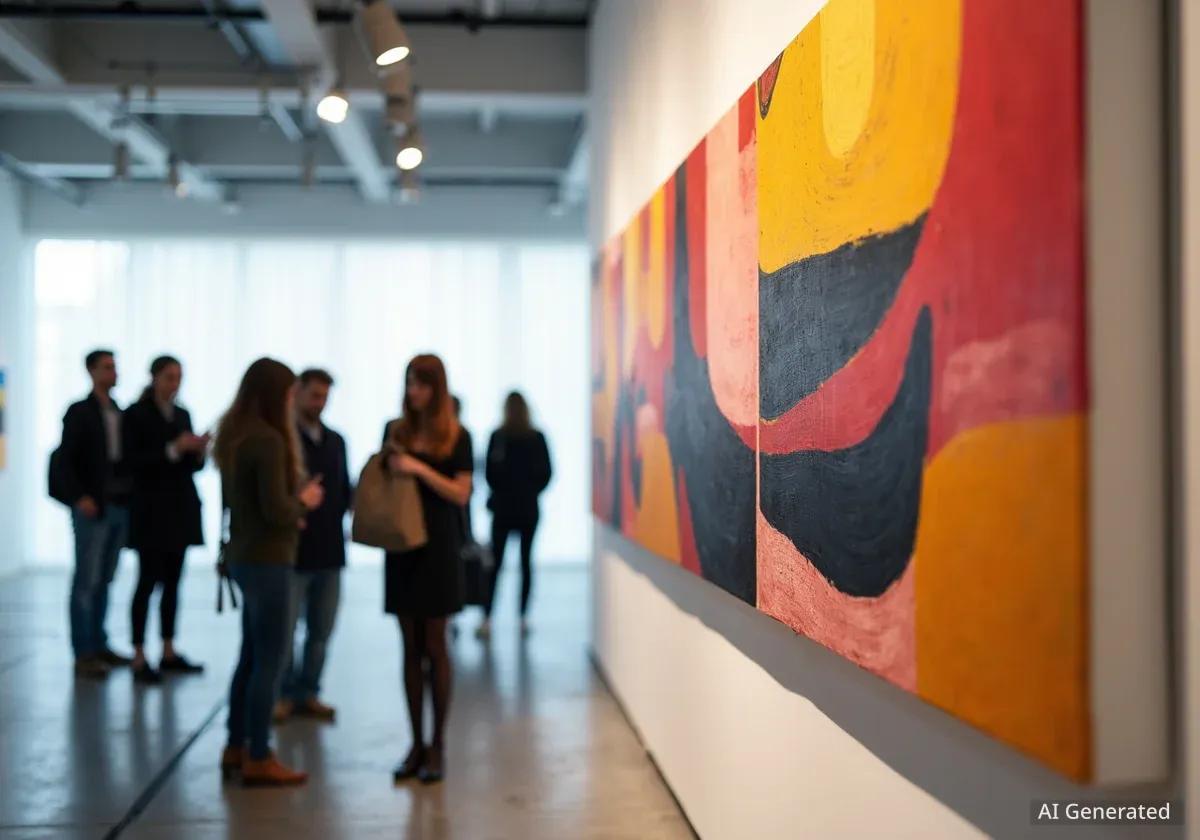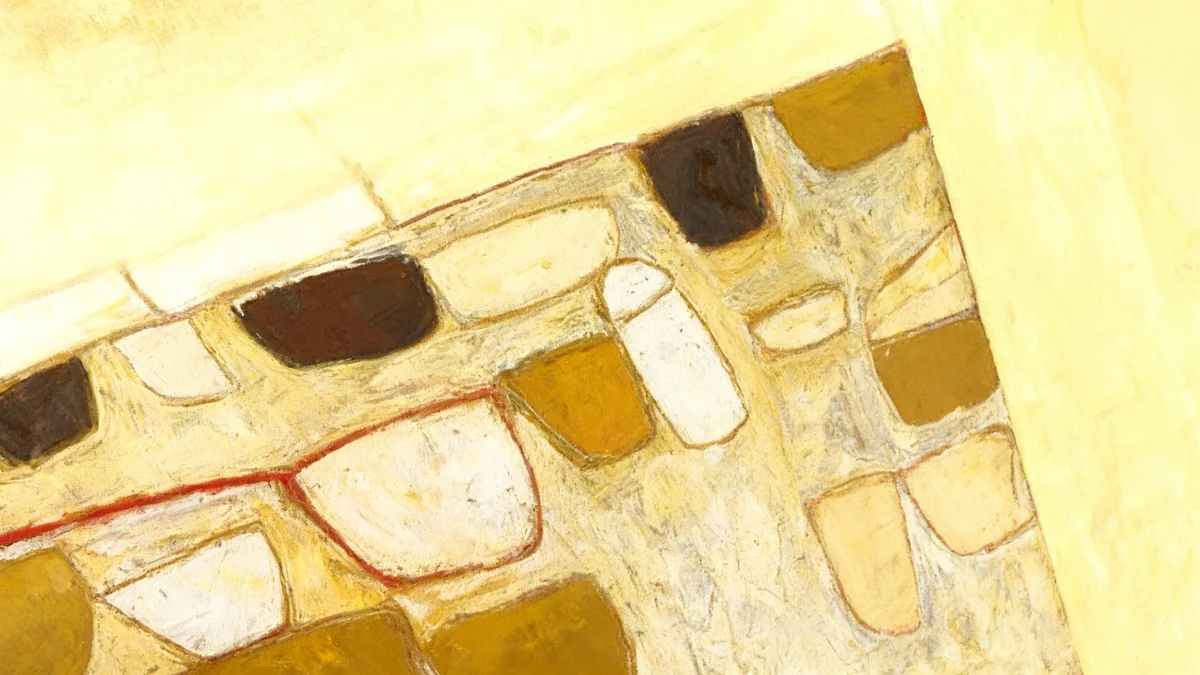An exhibition of new paintings by artist Judy Ledgerwood is currently on display at Gray Gallery's uptown location in New York City. The show features four large-scale works, all created in 2025, that explore themes of formal structure, color, and feminine expression. The paintings are notable for their specific dimensions, which appear to be influenced directly by the gallery walls where they are installed.
Upon entering the spacious gallery, visitors immediately notice how Ledgerwood's canvases interact with the architecture. Two of the four paintings occupy entire walls, while another wall features two equally sized canvases in a deliberate pairing. This arrangement invites viewers to consider the dialogue between individual artworks and their physical environment.
Key Takeaways
- Judy Ledgerwood's new exhibition features four large-scale paintings.
- The artworks' dimensions are tailored to Gray Gallery's uptown space.
- Ledgerwood uses geometric shapes, such as trefoils and quatrefoils, in her compositions.
- Her work blends elements of Pattern and Decoration with feminist themes.
- The exhibition runs through November 1, 2025.
Dimensions and Dialogue in New Works
The careful placement of Ledgerwood's paintings highlights her ongoing investigation into spatial relationships. The works, all from 2025, demonstrate her ability to manipulate formal structures within each piece while also considering their collective impact.
For example, "Vitamin C" features a skewed linear grid of unequal triangles. A hand-drawn trefoil design occupies this grid. In contrast, "Crepuscolo" presents a field of vibrant, mirrored trefoils spread across a single color background. These two pieces, hung on opposite walls, encourage a close examination of how they relate to each other and stand independently.
Exhibition Details
- Artist: Judy Ledgerwood
- Exhibition Title: Judy Ledgerwood: Twilight in the Wilderness
- Location: Gray New York, 1018 Madison Avenue, Floor 2, Upper East Side, Manhattan
- Dates: Through November 1, 2025
Evolution of a Painter's Style
Ledgerwood has a history of transforming established art movements. She is recognized for taking the rigid, repetitive nature of Pattern and Decoration art and infusing it with spontaneity and unexpected elements. Her approach introduces a sense of the fanciful and direct, often challenging traditional artistic decorum.
This lineage can be traced back to artists like Willem de Kooning. Ledgerwood, however, recontextualizes such influences, particularly regarding depictions of the female form. Her use of quatrefoils and trefoils, while appearing simple, often carries deeper layers of meaning related to female sexuality.
"I have always thought of Ledgerwood as a consummate painter who transformed the rigidity of Pattern and Decoration’s reliance on repetition into a mode of improvisation and surprise."
The visual language in Ledgerwood's art, sometimes described as "frankly vulgar" by observers, aims to celebrate female sexuality rather than objectify it. One critic previously compared her shapes to "Henri Matisse’s cut-outs [...] romanced by anthropomorphic cartoon mice." This comparison highlights the playful yet profound nature of her artistic commentary.
Color, Drawing, and Feminist Perspectives
The exhibition also explores the historical tension between drawing (disegno) and color (colore), two rival aesthetic approaches from Renaissance Italy. "Vitamin C" exemplifies Ledgerwood's mastery of drawing, while "Crepuscolo" showcases her vibrant use of color.
"Crepuscolo" is a striking example, featuring pulsating mauve quatrefoils and distorted variations against an orange background. Ledgerwood paints an orange rectangle with a sagging top and bottom edge, contrasting with the canvas's straight edges. Orange and mauve paint rivulets drip along the bottom, making the irregular rectangle resemble a draped cloth. This evokes comparisons to Henri Matisse's "The Pink Studio" (1911).
However, Ledgerwood’s "cloth" is made purely of paint and drips, emphasizing the materiality of the medium. This artistic choice suggests a desire to move decorative elements from traditionally private or public spaces, like a harem, into the intimate setting of a bedroom, where viewing art becomes a personal experience.
Art Historical Context: Disegno vs. Colore
In Renaissance Italy, "disegno" (drawing and design) emphasized intellectual and structural elements, often associated with Florentine art. "Colore" (color) focused on sensory and emotional impact, typically linked to Venetian painting. Ledgerwood's work often blurs these distinctions, showing how both elements contribute to a unified artistic vision.
Interplay of Shapes and Meanings
On a separate wall, the identically sized paintings "Alpen Glow" and "Golden Hour" further complicate the interplay of drawing and color. "Golden Hour" is a complex composition featuring a "crazy quilt" of triangles in various colors such as pale pink, blue, violet, and orange. It also includes solid lines and stained areas.
This work integrates different traditions of American painting, including Minimalism's grid, stain painting, and Pattern and Decoration. It reframes these styles within a feminist perspective without becoming overtly instructional. Some triangles are arranged to shift between flat shapes and two sides of a pyramid, creating an illusion of two-dimensionality and three-dimensionality.
Lines forming trefoils intersect across triangles, sometimes creating quatrefoils. This demonstrates how unexpected geometric relationships can emerge. Some trefoils humorously resemble graffiti-like male anatomy, while others appear as monochromatic silhouettes of cartoon rodents. This blend of antic humor, joyful irreverence, aesthetic discussion, and art historical references is a hallmark of Ledgerwood's style.
Sensuous Pleasures Through Limited Vocabulary
Ledgerwood often draws her trefoils with thick lines of paint, as seen in the saturated colors of "Alpen Glow." Some of these lines include drips, adding to the texture and visual interest. In the spaces where two lines meet, thick twists of paint create ambiguous forms. These forms evoke lines from Gertrude Stein's work, "Tender Buttons" (1914):
"Light blue and the same red with purple makes a change. It shows that there is no mistake. Any pink shows that and very likely it is reasonable."
This quote resonates with Ledgerwood's ability to create visually rich and sensuous experiences using a seemingly limited set of artistic elements. Her work consistently finds new avenues for visual pleasure and interpretation, inviting viewers to explore the layers of meaning within her abstract compositions.
The exhibition "Judy Ledgerwood: Twilight in the Wilderness" will remain open at Gray New York through November 1, 2025. It offers a compelling look at a contemporary artist who continues to push the boundaries of painting.




